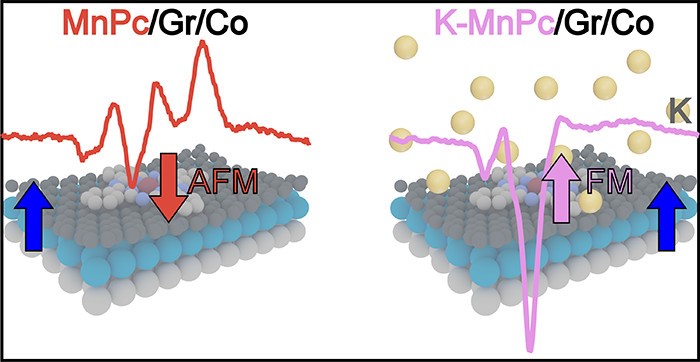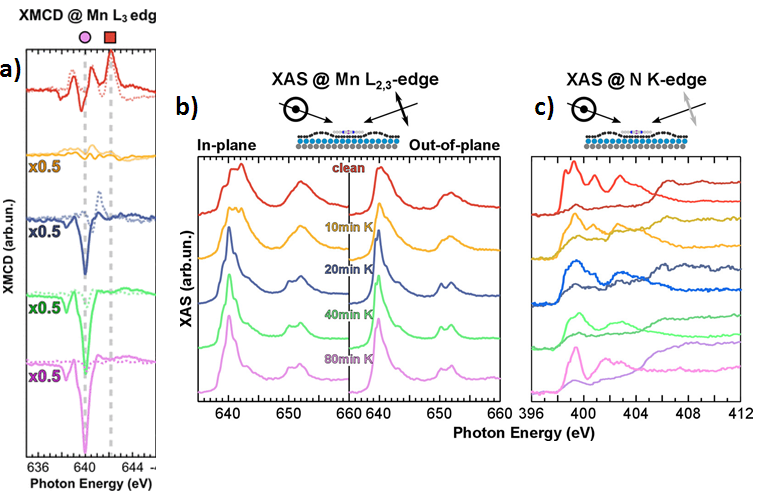
Figure. Schematic illustration of Ferromagnetic (FM) and Antiferromagnetic (AFM) Coupling of Spin Molecular Interfaces with High Thermal Stability.
Cerdanyola del Vallès, 23 February 2021. Spintronics is a rising field of electronics in which the spin of the electron, together with its charge, is generated, transported and collected in analogous ways as in classical electronics. The basic enablers of a spintronic device are a controllable spin current generator, a spin-current collector capable of detecting the spin current and a spin transport layer.
Metal-organic molecular semiconductors, thanks to their huge chemical flexibility, are regarded as potential promising building blocks in spintronics when their magnetic moments are stabilized, for example, by a controlled interaction with a magnetic substrate. The interface formed between metal-organic molecules and ferromagnetic substrates, the so called spinterface, plays a crucial role defining the spin-injection and detection capability of an organic spintronic device thus it is of fundamental importance to design and control its properties.
Researchers from the physics department at the Sapienza University in Roma led by prof. Maria Grazia Betti and in collaboration with the ALBA Synchrotron, discovered that a particular class of metal-organic molecules, metal-phthalocyanine, can be magnetically coupled through the graphene layer to the magnetic film via super-exchange interaction up to room temperature – as stated in a past publication.
Most notably they discovered that the graphene layer helps to protect the molecular electronic configuration, while at the same time allowing a strong magnetic interaction, enabling the design of molecular spin-interfaces with well-defined properties. In the work recently published in the journal Nano Letters, they showed how to tune the properties of the molecular spin-interface by chemically doping the metal-organic molecules.
In particular, they made a spin-interface based on manganese phthalocyanine (MnPc) deposited on a Graphene-covered Cobalt (Co) film grown on Iridium (Ir(111)).
This system demonstrates a robust antiparallel magnetic alignment between the Co and Mn magnetic moments, with the strongest interaction among the other transition-metal Pcs. The strong super-exchange magnetic interaction is mediated by the graphene extended pi orbitals and the metal-organic molecule organic ligand states.
This discovery opens a further way to modify and tune the properties of molecular spin-interfaces with possible application in spin-injector and spin-detector spintronic circuits.
X-Ray absorption measurements at the BOREAS beamline
Employing X-Ray Absorption Spectroscopy (XAS) and X-Ray Magnetic Circular Dichroism (XMCD) techniques at the BOREAS beamline of the ALBA Synchrotron, the researchers were able to follow the electronic and magnetic modification induced on the spin-interaface by the chemical electron-doping.
Injecting electrons in the molecular orbitals via alkali metal doping is a procedure vastly employed to tune the electronic properties in organic semiconductor devices.

Figure. a) XMCD as a function of K-doping showing the switching of the magnetic coupling sign and increasing magnetic polarizability of Mn ion; b,c) XAS of the Mn ion and N ligand atoms respectively showing the evolution of the Mn ion states as a function of doping indicating the swithc of the Mn ion to a high spin state and the evolution of the ligand state as a function of alkali metal doping.
Reference: Giulia Avvisati, Pierluigi Gargiani, Carlo Mariani, and Maria Grazia Betti. Tuning the Magnetic Coupling of a Molecular Spin Interface via Electron Doping. Nano Letters 2021 21 (1), 666-672 DOI: 10.1021/acs.nanolett.0c04256




